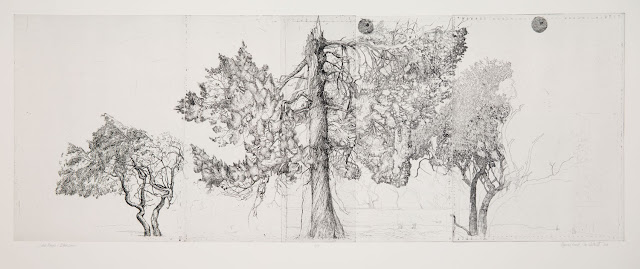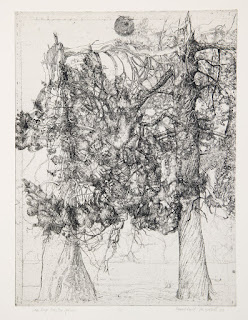Kapka Kassabova on the hidden power of trees and the work of Ian Westacott
 |
| Lake Mungo and Black Suns | copper etching with Raymond Arnold | 40cm x 108cm |
To look at an Ian Westacott tree is to step through a portal. His trees are as powerful as any human portrait, but free of agenda. They are individuals, a forest of one, captured at a specific moment in time at some remote location in Scotland, England, Sweden, or Australia. Here are beings that have borne weather and the consequence of human actions with an endurance that would be tempting to anthropomorphise – though Westacott never does. His erudition and old-worldly sensibility enable him to remain true to the arboreal essence of his subjects. In their presence your mind is stilled, while your eye seeks out the wrinkles, warts, scars, roots, fungi. Here, you recognise a face; there, the shadow of a violent blow remembered by the bark. An offering, a memorial, a celebration, apples like small suns – now it’s here, now it’s gone. Time disappears but the tree is there.
I look at his Scots Pines and instantly I’m transported to my childhood in the great Balkan Ranges, at the top of a firtree sticky with resin, alone and free. But also to Glen Affric, home to one of the last Caledonian forests in Scotland.
‘Everybody has a tree in their life. Everybody climbs one as a child.’ Ian Westacott said when I visited him in his Dornoch studio. ‘Sitting with a tree is peaceful.’
Like sitting with your oldest self. Westacott is softly spoken and seems drawn to secret places within and without. In some ways, he is an artist of the hidden self, a master of archetype. Born and raised in rural Australia, he moved to rural Scotland in his thirties and for years struggled with having nothing to hold on to in a foreign landscape. Then he started looking for historic trees, in which Scotland abounds. Stroke by stroke, he connected to the stories of this ancient land. Just as living in the Scottish Highlands has re-connected my writing to my native Balkans, Westacott’s artistic connection with Australia has been rekindled. Among his recent work are ghostly double etchings of acacias, the only tree that survives in the Australian desert. In these ‘double vision’ etchings, the second vision is created by fellow artist Raymond Arnold. The effect is haunting. These thorny acacias are truly denizens of Aboriginal Dreamtime. And Dreamtime, like the Omphalos, is where the world tree originates.
 |
| Lake Mungo Murry Pine |
The world tree makes the world forest which is home not only to biological diversity and climate equilibrium (as if this weren’t enough), but of the human story too. Myth, folklore, and communal narratives come from the forest of what Carl Jung called the collective unconscious. The forest is our shared imaginative identity. In the forests of northern Europe live gnomes, nymphs, the Rapunzels, Rumpelstiltskins, Hansels and Gretels of fairy tales. In southern Europe, creatures of the Slavic imagination roam the narrative forest: the witchy baba Yaga, cave-dwelling dragons, eery maiden vilas only seen at moonlight, and the undead varkolaks and talasums.
But in Westacott’s trees, I also see holograms, the morphic resonance of the slaughtered. The uprooted or dying tree is a theme in Westacott’s work – it is a tree that he sees everywhere he goes. Trees die from the top first, he tells me. It is symbolic of self-harm, and the hole it leaves is our communal wound. I see this everywhere too, as tree populations fall every year across the globe. Across the road from our house in Inverness-shire, a mixed forest of sublime beauty stood where a quarry now eviscerates the earth. Each year, it chomps its way deeper into the shrinking glade, giving the old forest path a sheer drop into the pit. And a length of barbed wire.
The world tree is endangered by human expediency, by a failure of love. When I look at an Ian Westacott tree, I am reminded to lie under the wild geans in the garden and watch the sky move through their crowns. Lest we forget that we are nothing more, and nothing less, than the world tree – our feet planted on the earth, our spirit reaching into the cosmos.
Kapka Kassabova, May 2018
Kapka Kassabova is a poet and writer. Her latest book ‘Border - a Journey to the Edge of Europe’ won the Saltire Society Book of the Year, the Edward Stanford Dolman Travel Book of the Year and the Highland Book Prize.
published in our Magalogue number three. Please contact the gallery for a printed version.
Comments
Post a Comment